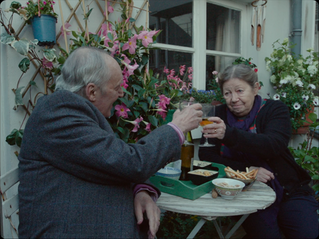Thelma & Louise
- Olivia E. Taylor
- Nov 15, 2022
- 3 min read
Ridley Scott, 1991

Ride or die. Die or Ride. The highways and intersections of outer Arkansas are littered with lorries and the unpleasant men that drive them. Horns, tires and motors bleed into each other and become one large howl in an echo chamber of vehicles. Under a bridge, Louise throws up the liquor she had consumed earlier that evening. From the time between her first drink and this moment she had witnessed her darling best friend Thelma sexually assaulted and consequently, vengefully, shot the perpetrator with his pants down. Shock and horror and booze -- all culminate into this one grand combustion of feeling. Spew on her turquoise 1966 Thunderbird’s wheels; bent over in her Levi’s with doe-eyed beauty queen Thelma in the passenger seat holding her crotch. It’s not quite the trip she had planned.
Controversial upon release due to its overt feminism and exceptional ending, Thelma & Louise balances itself between a road-trip flick and a sociopolitical drama. Confined by the pressures of their sex and roles in America’s post-war-50s and pre-sexual-liberation of the 70s, the duo embark on a holiday they hoped would allow them to ignore the pressures of being a woman during this time. Tragically, the opposite ensues; and every step of the way they are betrayed by the opposite sex. Screenwriter Callie Khouri portrays the American woman in Thelma & Louise as radically disenfranchised by the world surrounding them. The answer to their survival is to destroy everything on their path, this includes; husbands, boyfriends, policemen, detectives, lorry drivers and beautiful criminals (Brad Pitt). The women establish killing as a survival technique not because they’re romantically escaping to express boundless love for each-other like Bonnie and Clyde (1967) or Kit and Holly in Badlands (1973). Rather, Thelma and Louise kill to carry on. They love each other platonically and entirely; like waves meet the shore, Louise is stoic and certain whilst Thelma moves fleetingly and wild through trauma. They both want the other to thrive; to exist beyond the idea of the ‘perfect woman.' They dismantle their internalised misogyny by supporting each other, by and large convincing each other to split with their significant others. But most poignantly, deconstructing the male gaze; wholly demonstrated in the line, “No, you’ve always been crazy. This is just the first chance you've ever had to really express yourself,” further revealing their unwavering championship of each other.
Think the American road trip; think Easy Rider (1969); oiled motorbikes, dusted Californian roads, Born To Be Wild by Steppenwolf, long hair blowing in the wind. Easy Rider symbolises the male-centric hippy fantasy of the 60s. In comparison, Thelma & Louise is headier, darker. On the run from the police, fighting for survival and underestimated every step of the way. Easy Rider is misunderstood; Thelma & Louise is war. Aesthetically, the feature pulls from the road-trip genre in style and symbolism. The use of a tracking camera to follow the miles travelled along highways and deserts. Withdrawn motels filled with an assortment of strangers. Ripped articles of clothing that collect hours of sweat. Muddied faces with rosy cheeks. These features convey the arduous journey taken, this is most obviously shown in Thelma's attempts to preserve her femininity via her dress code. She begins in a white dress, a bikini and lipstick then swiftly develops into a ripped t-shirt, dirtied jeans and boots, metaphorically displaying her transition to independence. By the apex of her journey Thelma states, “I don't recall ever feeling this awake. You know? Everything looks different now. You feel like that? You feel like you got something to live for now?” Inversely, from the get-go Louise is dressed androgynously, adorning a buttoned shirt and gaudy scarf covering her head, possibly displaying confidence in her sexuality. Or rather, her fear of sexualisation (something she is acutely aware of), an example of this is in Louise’s resentment to Thelma’s “openness” as she judges her decisions like dancing with a stranger in a bar or trusting the handsome student who needs a ride. Worn by the road, Louise slowly exposes her skin, opting for torn vests instead of neck-high shirts. Her fierce attempts to prove herself dissipates. She realises no matter how she dresses, she is still a woman and there's no escaping that.
Primarily, Thelma & Louise is an ‘us against the world’ fable; it’s a freedom that crashes. They decide their ending, tragic or not, is better than the archetypal ‘happily ever after.’ Their determination to experience freedom takes over their embedded guilt women unfortunately possess. Thelma & Louise shows the beauty in partnership; the beauty in gambling everything against the odds. Their pilgrimage together ebbs and flows between escape and resolution until the pair fly like an American eagle, soaring over the grand canyon hand in hand. Sexism, crime and social confinement; these pains of femininity cut deep, still; the plight of a woman is easier done with a friend.








Comments